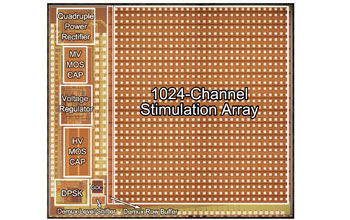All Images
News Release 13-026
Artificial Retina Receives FDA Approval
Argus II is first approved prosthesis to restore limited vision to those blinded by retinitis pigmentosa
This material is available primarily for archival purposes. Telephone numbers or other contact information may be out of date; please see current contact information at media contacts.
Researchers and patients describe concepts and early devices that led to the Argus II.
Credit: NSF

While the Argus II is a major breakthrough in retinal prosthetics, researchers are continuing their research. This third-generation retina chip, itself still very early in the development stage, contains 1,000 electrodes and was developed by Wentai Liu, a professor of bioengineering at the UCLA Henry Samueli School of Engineering and Applied Science and his colleagues. Early engineering done by Liu and his team was licensed to Second Sight for the Argus II Retinal Prosthesis System.
Credit: Wentai Liu, UCLA
Download the high-resolution JPG version of the image. (775 KB)
Use your mouse to right-click (Mac users may need to Ctrl-click) the link above and choose the option that will save the file or target to your computer.
NSF program officers who have supported the development of the artificial retina prosthesis since the 1990s share personal stories about their experiences.
Credit: NSF
Artificial retina co-developer Mark Humayun explains the retinal prosthesis in a presentation at the National Science Foundation.
Credit: NSF
Popular Mechanics senior science editor Jennifer Bogo hosts a discussion with the developers of the Argus II artificial retina and Barbara Campbell, the 25th recipient of the device.
Credit: Popular Mechanics
